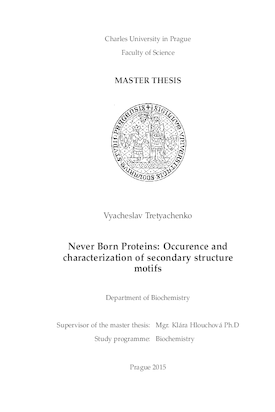Never Born Proteins: Occurence and characterization of secondary structure motifs
Výskyt a charakterizace sekundárních struktur u nových proteinových sekvencí (never born proteins)
diplomová práce (OBHÁJENO)

Zobrazit/
Trvalý odkaz
http://hdl.handle.net/20.500.11956/84129Identifikátory
SIS: 141258
Katalog UK: 990020276310106986
Kolekce
- Kvalifikační práce [21483]
Autor
Vedoucí práce
Oponent práce
Kopecký, Vladimír
Fakulta / součást
Přírodovědecká fakulta
Obor
Biochemie
Katedra / ústav / klinika
Katedra biochemie
Datum obhajoby
7. 9. 2015
Nakladatel
Univerzita Karlova, Přírodovědecká fakultaJazyk
Angličtina
Známka
Velmi dobře
Klíčová slova (česky)
struktura bílkovin, genetický kód, (in vitro) evoluce, proteinové inženýrstvíKlíčová slova (anglicky)
protein structure, genetic code, (in vitro) evolution, protein engineeringStudium náhodných proteinových sekvencí skýtá velký potenciál pro pochopení původu a mechanismu tvorby hydrofobního jádra a uspořádané struktury proteinů. V této práci byla provedena biofyzikální charakterizace pěti proteinových sekvencí bez homologie s dosud známými proteiny. Sekvence byly vybrány na základě bioinformatické analýzy, jenž spočívala ve vyhodnocení 10 0000 náhodných polypeptidových řetězců pomoci prediktorů sekundárních struktur, rozpustnosti a celkové proteinové neuspořádánosti. Charakterizace vedla k potvrzeni přítomnosti sekundárních struktur a v některých případech také k odhalení náznaků nativního uspořádání proteinů - tvorby stabilního hydrofobního jádra a tendenci k specifické oligomerizaci. Přestože uvedená práce je pouze součásti většího projektu, výsledky již teď naznačují, že náhodne proteinové sekvence mají potenciál k tvorbě sekundární i terciární struktury Powered by TCPDF (www.tcpdf.org)
An experimental study on randomly generated protein sequences can provide important insights into the origin and mechanism of secondary structure formation and protein folding. In this study we bring biophysical characterization of five protein sequences selected from the in silico generated library of random chains. The sequences were selected on the basis of bioinformatic analysis in order to find the candidates with the maximum potential to possess secondary structure. This study shows that the random polypeptide sequences form stable secondary structures and in some show the signs of tertiary structure, such as hydrophobic core formation and distinctive oligomerization pattern. While the work presented in this thesis is work in progress on a larger study, the data already demonstrate that unevolved protein sequence space provides a lot of potential for secondary and tertiary structure formation that awaits its characterization. Powered by TCPDF (www.tcpdf.org)
